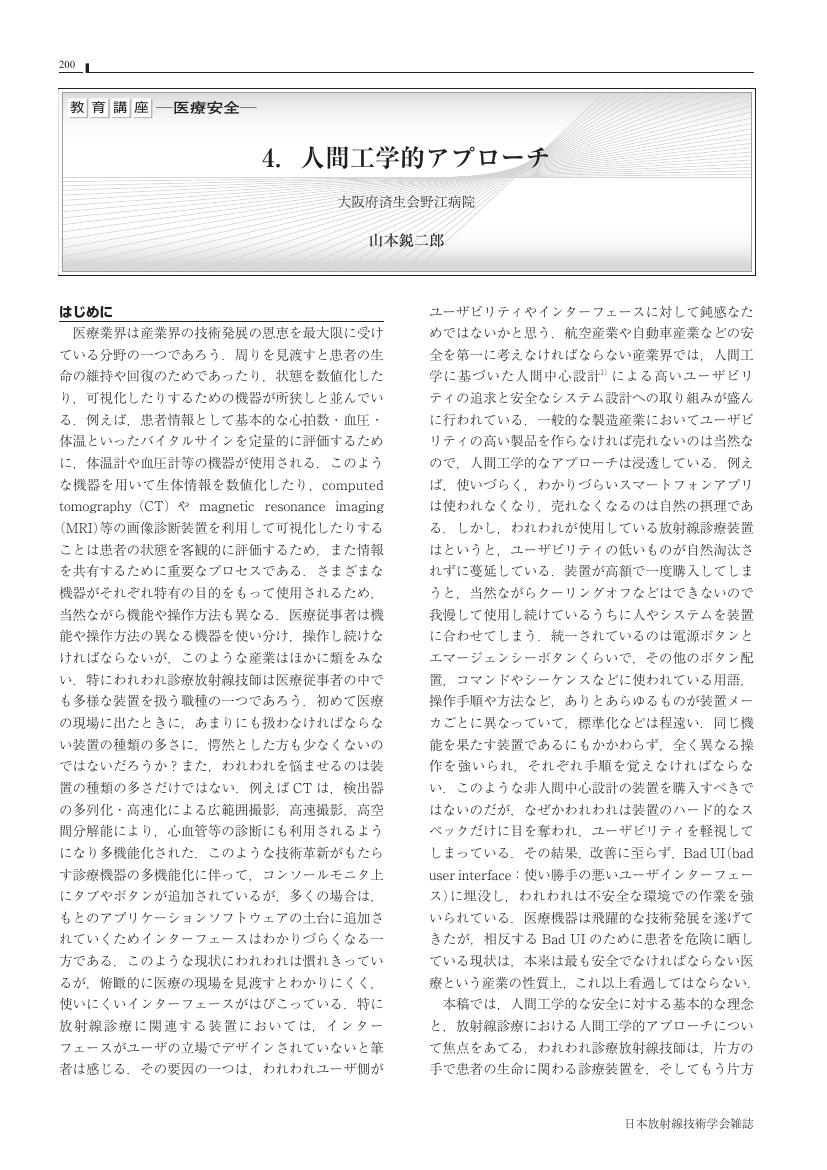1 0 0 0 4. 人間工学的アプローチ
- 著者
- 山本 鋭二郎
- 出版者
- 公益社団法人 日本放射線技術学会
- 雑誌
- 日本放射線技術学会雑誌 (ISSN:03694305)
- 巻号頁・発行日
- vol.77, no.2, pp.200-211, 2021 (Released:2021-02-20)
- 参考文献数
- 13
- 著者
- 岡本 裕之 太田 誠一 川守田 龍 坂本 昌隆 中村 哲志 西岡 史絵 株木 重人 正井 範尚 水野 統文 古谷 智久 山本 鋭二郎 飯島 康太郎 伊藤 芳紀 勝田 昭一 黒岡 将彦 川村 愼二 橘 英伸 遠山 尚紀 中村 勝 峯村 俊行 中山 優子
- 出版者
- 公益社団法人 日本医学物理学会
- 雑誌
- 医学物理 (ISSN:13455354)
- 巻号頁・発行日
- vol.40, no.1, pp.28-34, 2020-03-31 (Released:2020-03-31)
- 参考文献数
- 2
In 2016, the American Association of Physicists in Medicine (AAPM) has published a report of task group (TG) 100 with a completely new concept, entitled “application of risk analysis methods to radiation therapy quality management.” TG-100 proposed implementation of risk analysis in radiotherapy to prevent harmful radiotherapy accidents. In addition, it enables us to conduct efficient and effective quality management in not only advanced radiotherapy such as intensity-modulated radiotherapy and image-guided radiotherapy but also new technology in radiotherapy. It should be noted that treatment process in modern radiotherapy is absolutely more complex and it needs skillful staff and adequate resources. TG-100 methodology could identify weakness in radiotherapy procedure through assessment of failure modes that could occur in overall treatment processes. All staff in radiotherapy have to explore quality management in radiotherapy safety.
1 0 0 0 OA 放射線治療におけるインシデント事例に対する VTA を用いたヒューマンファクタ研究
- 著者
- 山本 鋭二郎 岡 耕平
- 出版者
- 公益社団法人 日本放射線技術学会
- 雑誌
- 日本放射線技術学会雑誌 (ISSN:03694305)
- 巻号頁・発行日
- vol.75, no.11, pp.1249-1259, 2019 (Released:2019-11-20)
- 参考文献数
- 15
In recent years, workload has increased with higher precision of radiotherapy. Although both efficiency and thoroughness of treatment are crucial, in such conditions, human error is easy to occur. In this study, five incident cases that occurred in four facilities were studied and analyzed from the viewpoint of human factors that contribute to errors using variation tree analysis. We also analyzed resilience (the ability to return to one’s original state even if the system deviates from a stable state), which has attracted attention in recent safety research. There were potential factors represented by patient factors in all cases. These factors caused deviations from standard operations, and incidents occurred due to unfamiliar situations and operations. Furthermore, in four of the five cases, the cause of the incident was a resilience action or judgment that was deemed to have required “some sort of ingenuity or adjustment.” It was found that human error occurred due to multiple simultaneous occurrences of potential factors, i.e., patient and human factors such as high workload, impatience, and work interruptions. A reduction in human errors can be achieved by avoiding time pressure and multitasking, creating work environment and working conditions that make resilience work well, revising ambiguous rules and procedures, and promoting standardized working methods.
